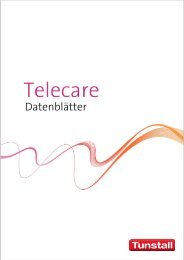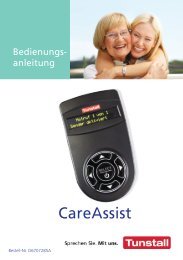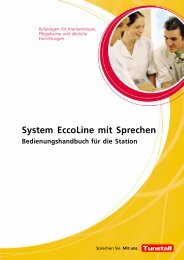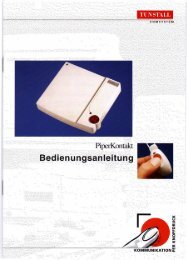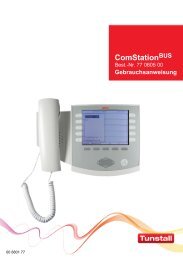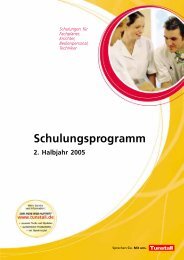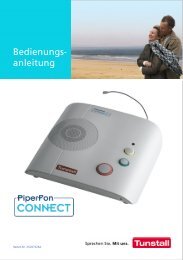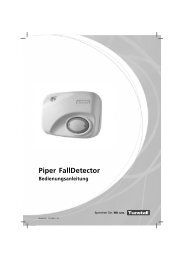You also want an ePaper? Increase the reach of your titles
YUMPU automatically turns print PDFs into web optimized ePapers that Google loves.
<strong>Tunstall</strong> <strong>GmbH</strong>, Orkotten 66, D-48291 Telgte, www.tunstall.de<br />
Management Interface, Order no. 19 0700 00<br />
Telephone module settings<br />
1. Select “Telephone module” in the Main Menu.<br />
The “Telephone Module” menu is displayed, see Fig. M.<br />
2. Select “Telephone Module ON/OFF”.<br />
The submenu “Telephone module ON/OFF” is displayed.<br />
3. Select “ON”, if a telephone system is connected.<br />
Select “OFF”, if no telephone system is connected.<br />
Test telephone call<br />
1. In the “Telephone Module“ menu select “Test Call”.<br />
“Tel. No.:” is displayed.<br />
2. Enter the telephone number to be dialled.<br />
3. Press Enter.<br />
The telephone is called. Then a speech message is<br />
transmitted, which should be followed.<br />
4. To close the “Telephone Module” menu, press Clear.<br />
Settings only with the service password<br />
If the Management Interface is connected to the ward bus, the<br />
menu item “Group Bus / Ward bus” must be changed from fact‐<br />
ory setting “Group Bus” to “Ward Bus”.<br />
If required the following factory settings can be changed:<br />
- Volume Settings: Volume Speech Phrases, Gain Modem<br />
Speaker, Gain Modem Mic<br />
- Speech Phrases (ON)<br />
- Call Delays: Call Delay Telephone* (0 min), Call Delay DECT<br />
(0 min), Call Delay Common (5 sec)<br />
- No. of Call Repeats* (3)<br />
- Delay Between Calls (10 sec)<br />
- Max. Talk Time* (2 min)<br />
- On Hook Timeout (60 sec)<br />
- Line Busy Timeout (30 sec)<br />
- No. of Call Repeats on Busy (3)<br />
- Speech Format (Room 1-2-3-4)<br />
- CPC Protocol (PNC)<br />
* = The settings marked with a * will be overwritten by ConLog<br />
settings (“Project Configuration” menu).<br />
System Test<br />
Select „System Test“ in the Main Menu.<br />
The “System Test” menu is displayed, see Fig. N.<br />
Sending a test message to a pager or a DECT telephone<br />
1. Select “Test Paging (ESPA 4.4.4)”.<br />
“Pager Address:” is displayed.<br />
2. Enter the pager address for the test message.<br />
3. Press Enter.<br />
The Test message “Testmessage“ is sent.<br />
Test telephone call<br />
1. Select “Test Telephone Call”.<br />
“Tel. No.:” is displayed.<br />
2. Enter the telephone number to be dialled.<br />
3. Press Enter.<br />
The telephone is called. Then a speech message is<br />
transmitted, which should be followed.<br />
Trigger a test message at the fault output<br />
1. Select “Test Fault Relay”.<br />
The fault relay is switched. “Relay Test” is displayed.<br />
2. To finish the test press Enter.<br />
00 8814 00, 10/12 (Rev. 4.0) 5<br />
<strong>Technical</strong> <strong>Manual</strong> Page 131<br />
Telephone Module<br />
Telephone Module ON/OFF<br />
Test Call<br />
OFF<br />
Bus ConLog Tel. Paging<br />
System Test<br />
Test Paging (ESPA 4.4.4)<br />
Test Telephone Call<br />
Test Fault Relay<br />
Bus ConLog Tel. Paging



